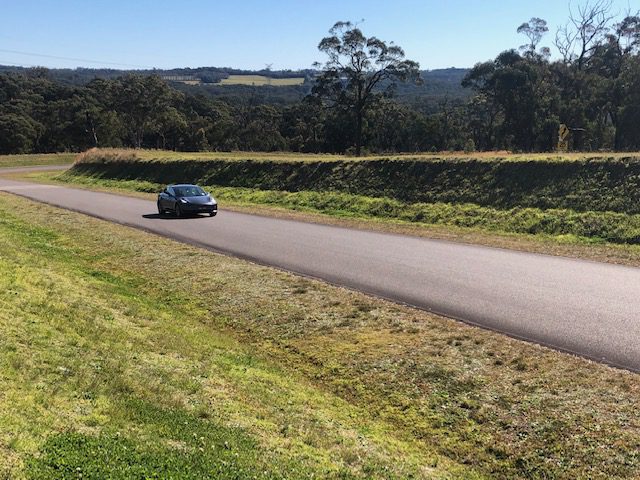This was so very Tesla. More than three years after the Model 3 electric car was first unveiled, we are gathered at a private track north of Sydney for the first test drive in Australia, being briefed by a Tesla executive who can’t be named.
Tesla has a rule, or should we say a quirk, which is that no one – apart from co-founder and CEO Elon Musk – can be quoted by name. But if anonymity rules for the staff, it is the opposite for its CEO and its products.
Tesla enthusiasts put up with such idiosyncrasies – as they do with changing time-lines, inclusions and pricing – without complaining, much. Once you drive one of their cars, you understand why. You are hooked. Petrol and diesel cars seem so passe. So noisy. So polluting. So costly to run. And they don’t drive nearly as well.
The Model 3 has been one of the most anticipated cars in the history of the automotive industry, and without doubt the most anticipated electric vehicle.
Thousands in Australia, and nearly half a million around the world, paid a $US1,000 deposit, without so much as seeing the detailed design, let alone sit in one or take one for a test drive. They are configuring their vehicles online. Most have never seen one.
Why do they do this? Because they were, and are, inspired by Musk’s vision, the technology, the anticipated performance and the promised safety – all of which has been delivered, by the way – and the significance of its role in cementing the transition from fossil fuels to a zero emissions electric future.
The Model 3 was supposed to be a $US35,000 “mass market” car, or $A50,000 in rough terms in Australian dollars at the time. But Tesla couldn’t help itself, and the performance (PD) models that we test-drove briefly on Tuesday are around $100,000 once they are on the road.
The cheapest version of the Model 3, the standard range plus, starts at $66,000 plus on road costs. That’s more than the recently released Hyundai Kona (around $60,000 plus), the Ioniq ($50,000 plus), and the Nissan Leaf ($50,000 plus).
But this is in a different league. The price may not be mass market, but it sales indicate otherwise. It has out-sold all its luxury competitors in the US, put together, and is by far the leading EV in Europe on sales volumes.
 For this Australia-first test drive, the assembled auto media was provided with those top-of-the-range performance models to do four laps around a windy 5km track. Whoever built this track sure does like corners.
For this Australia-first test drive, the assembled auto media was provided with those top-of-the-range performance models to do four laps around a windy 5km track. Whoever built this track sure does like corners.
And those auto journalists must have early deadlines, because this felt more like a race than a casual and exploratory drive. First impressions? It was just enough time to realise that this is a truly amazing car – extraordinary acceleration, great handling, and a ground-breaker in design terms in so many ways.
You don’t get a great feel for the whole package in just 15 minutes, particularly an electric car, because it is about so much more than raw performance. It is also about the significant environmental savings, the fact that you charge the car (mostly at home), rather than re-fuel it, and because it is a step change in mobility.
But for the performance that can be measured in a 20km drive as fast as you dare, or are capable of, then it ticks all the boxes.
The performance model has a top speed of 261km and acceleration from 0-100kms in 3.4 seconds. Unlike others, I only got around half way to the former, and didn’t really measure how close I got to the second. Suffice to say it was damn responsive. It has a range of 560km, but we didn’t have time to test that.
It handled, like most EVs, beautifully through the corners. The weight of the batteries gives it a low centre of gravity. The electric motor gives it instant torque, from zero up. There’s other auto-nerdy stuff that makes it really special.
Regeneration delivers an added experience in electric vehicles, meaning you don’t need to use brakes as much, or at all. This is a key aspect of EV driving.
Curiously, because the battery in my Model 3 PD was nearly fully charged, the re-gen was not coming in as much as it would have with a lesser charged battery.
The Tesla boffins say they see no need to put charge back into a battery that is nearly fully charged. That meant I was using the brake pedal more than I expected. Once the regen did come into effect, it felt good. Very good.
Luckily, and perhaps because I do have a standard range plus version on order, I also got to do two laps in one of those. (The blue one below) Here, the top speed is 225km and acceleration from 0-100 takes nearly double the time of the PD version, 5.6 seconds. The range is 460km.
My best advice? Drive the SR plus before the PD.
 The SR plus is definitely shaded by the better performance of the performance version, as you would expect. It’s not quite as explosive in acceleration, and has a lighter feel (thanks to less battery capacity) in the corners.
The SR plus is definitely shaded by the better performance of the performance version, as you would expect. It’s not quite as explosive in acceleration, and has a lighter feel (thanks to less battery capacity) in the corners.
But really, 0-100 in 5.6 seconds and a top speed twice the legal limit in Australia is ample enough. I drove the SR+ for less than 10 minutes. It ticked all the boxes I wanted it to tick. I’m not cancelling my booking, or regretting passing on the Hyundai Kona, as nice as that was.
Is the Model 3 as good as the Model S and Model X?
Yes. For a start, it is cheaper. But it is wrong to compare them directly because that will come down to personal choice and needs. They are three quite different vehicles. All are pushing the boundaries of what to expect of a car in different ways.
The design for the Model 3 started in 2015 with nothing more than a price point – the $US35,000 stipulated by Musk – and otherwise a clean slate.
It does clearly, however, have some of the family genes. The first thing you notice is that it is shorter (30cm) and thinner (10cm) than its nearest cousin, the Model S. Like the Model X, it has a glass roof and a panoramic view.
It has retractable handles that fit flush to the door. They don’t open automatically (they don’t “self present” as the Tesla people say) on approach like the Model S, but they are pressed open.
There is no key (unless you really, really want one). The car is opened with your phone, as you approach, and locks as you walk away. It is backed up by two hotel-style electronic cards that you can keep in your wallet or elsewhere.
Inside, the first thing you notice is the minimalist set up and the 15 inch screen that dominates the interior.
This, apparently, was the aspect the designers agonised over the most.
They decided that getting rid of all the buttons and dials would mean the car wouldn’t be easily dated, could in fact be updated (through software downloads), and made sense in an auto-pilot future.
The lack of instrumentation means that the driver sits further forward than he might have otherwise. This gives more space to the second row, and therefore the boot.
The HVAC – heating, ventilation, and air con – is unlike anything else. Because of the glass roof, it needs directional air, so Tesla has developed a whole new way to distribute it.
It has hidden vents that go left and right, another that runs vertically and all can be controlled by pinching or spreading your fingers on the screen. You can literally drag where you want the air to flow.
On the steering wheel, Tesla have gone with “rolling thumb wheels”, which click left and right, up and down and can be pushed.
A whole bunch of things can be set with those controls, from the mirrors to position of the steering wheel, and the speed settings and distance on autopilot.
 There are only stalks on the steering column. One is for the indicator, lights and and windscreen wipers and wash. The other is for autopilot.
There are only stalks on the steering column. One is for the indicator, lights and and windscreen wipers and wash. The other is for autopilot.
Did I miss all the other nobs and displays you find in other vehicles? No. I was watching the road. And as Tesla suggests, if the future is auto-pilot, who wants to have so much instrumentation. Just play that video.
Tesla Model 3 is now in full swing. In the afternoon, a certain group of Tesla owners were being offered test drives on the track. In the next week or two, they will start appearing on the roads, and mainstream media will start talking about them.
By the end of the month, the first deliveries will take place. By the end of the year, it will be no surprise to find the Model 3 is the best selling EV in Australia.
If my chats with the assembled auto journalists are any guide, there will be discussions and views about build quality and service. Not everyone loves EVs. Some of us like noise and fumes. But one thing is certain, the Model 3 will help change the conversation about mobility forever.

Giles Parkinson is founder and editor of The Driven, and also edits and founded the Renew Economy and One Step Off The Grid web sites. He has been a journalist for nearly 40 years, is a former business and deputy editor of the Australian Financial Review, and owns a Tesla Model 3.

